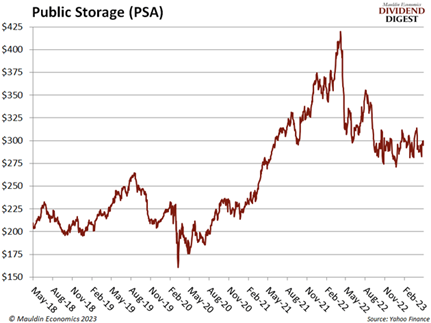Americans have too much stuff—one in five already use a self-storage facility, and another 15% intend to rent space. Public Storage (PSA) is the current leader in both revenues and facilities, and is worth a look, writes Kelly Green, editor of Dividend Digest.
As I head to my home office, I look out the living room window to check the sky. More than once, I’ve been tricked into thinking we’re due for torrential rain when I spot the gray wall of the recently erected CubeSmart, a monstrosity that towers over my neighbors’ homes.
The explosion of these facilities isn’t unique to my neighborhood. Over the last five years alone, 252.3 million square feet of storage space has been built. That’s billions of dollars in construction.
There’s now over 2 billion square feet of storage space in the US. Of the estimated 51,206 storage facilities, 36.6% of those are owned by the top six operators…all of which are publicly traded.
PSA opened its first facility in 1972 and has grown to become the largest owner and operator of self-storage facilities in the world. It has thousands of locations across the US and Europe, with more than 170 million rentable square feet. The company brought in $4.24 billion in revenues in 2022. That was a 21% growth over 2021.
Public Storage has paid a quarterly dividend to its shareholders since December 1995. And its current payment of $3 recently equaled an annual yield of 4%. Its trailing 12 months (TTM) yield is double that, as shareholders received a one-time special dividend last August related to the acquisition of PS Business Parks.
Investors have noticed the value here.

Despite dropping from 2021 record highs, shares are still up 40% over the past five years. But as PSA continues to grow, there will be capital gains to be made.
The self-storage business has a recession-proof nature. In fact, when things get rough, we see more people using the extra space.
During the height of COVID, demand spiked. Consumers experienced displacement, downsizing, relocation, home remodels, and divorce, just to name a few. Still, hundreds of thousands of Americans experience these things every year, so the demand for storage remains strong even without a pandemic.
That said, I anticipate some volatility in public storage over the next few years. As you can see by the stock chart above, the industry saw record highs in 2021–2022. And 2023 is going to be a normalization year across the board.

















